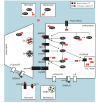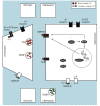Long-term potentiation in spinal nociceptive pathways as a novel target for pain therapy
- PMID: 21443797
- PMCID: PMC3078873
- DOI: 10.1186/1744-8069-7-20
Long-term potentiation in spinal nociceptive pathways as a novel target for pain therapy
Abstract
Long-term potentiation (LTP) in nociceptive spinal pathways shares several features with hyperalgesia and has been proposed to be a cellular mechanism of pain amplification in acute and chronic pain states. Spinal LTP is typically induced by noxious input and has therefore been hypothesized to contribute to acute postoperative pain and to forms of chronic pain that develop from an initial painful event, peripheral inflammation or neuropathy. Under this assumption, preventing LTP induction may help to prevent the development of exaggerated postoperative pain and reversing established LTP may help to treat patients who have an LTP component to their chronic pain. Spinal LTP is also induced by abrupt opioid withdrawal, making it a possible mechanism of some forms of opioid-induced hyperalgesia. Here, we give an overview of targets for preventing LTP induction and modifying established LTP as identified in animal studies. We discuss which of the various symptoms of human experimental and clinical pain may be manifestations of spinal LTP, review the pharmacology of these possible human LTP manifestations and compare it to the pharmacology of spinal LTP in rodents.
Figures
References
-
- Sandkühler J. Models and mechanisms of hyperalgesia and allodynia. Physiol Rev. 2009;89:707–758. - PubMed
-
- Liu X, Sandkühler J. Characterization of long-term potentiation of C-fiber-evoked potentials in spinal dorsal horn of adult rat: essential role of NK1 and NK2 receptors. J Neurophysiol. 1997;78:1973–1982. - PubMed
Publication types
MeSH terms
Grants and funding
LinkOut - more resources
Full Text Sources
Medical



